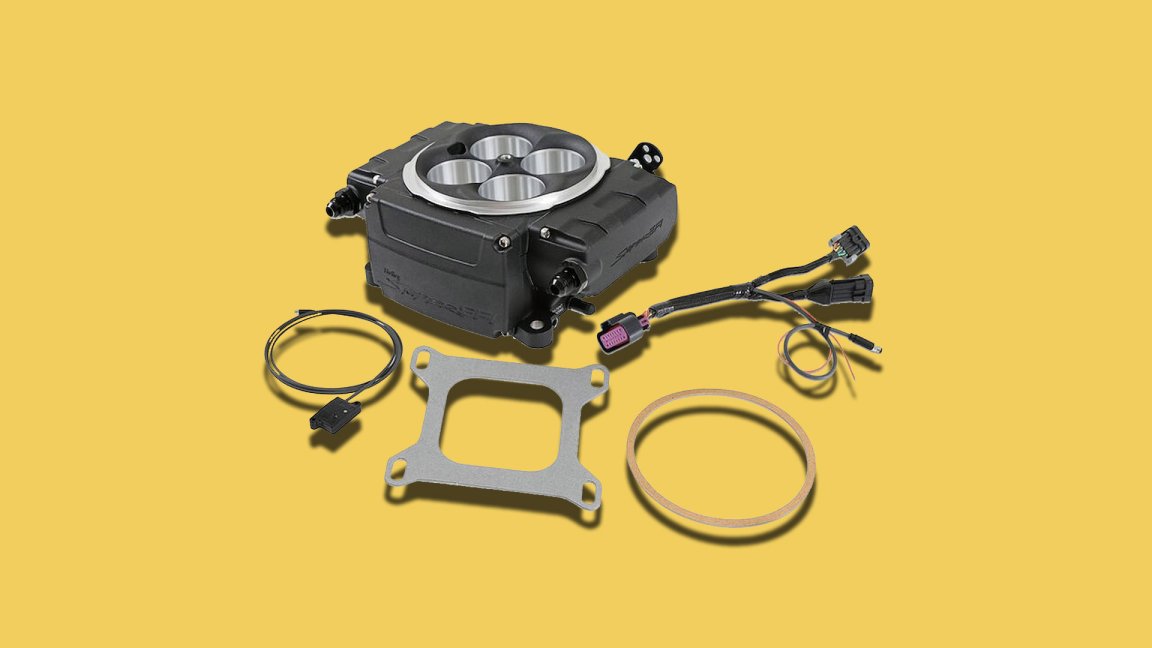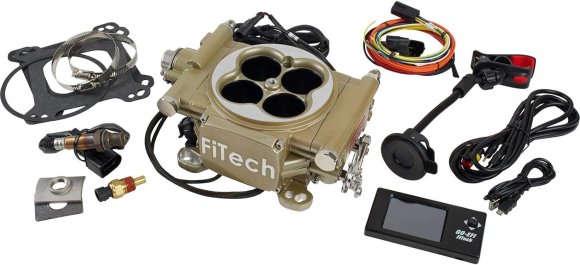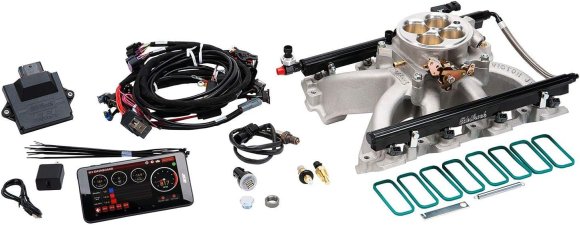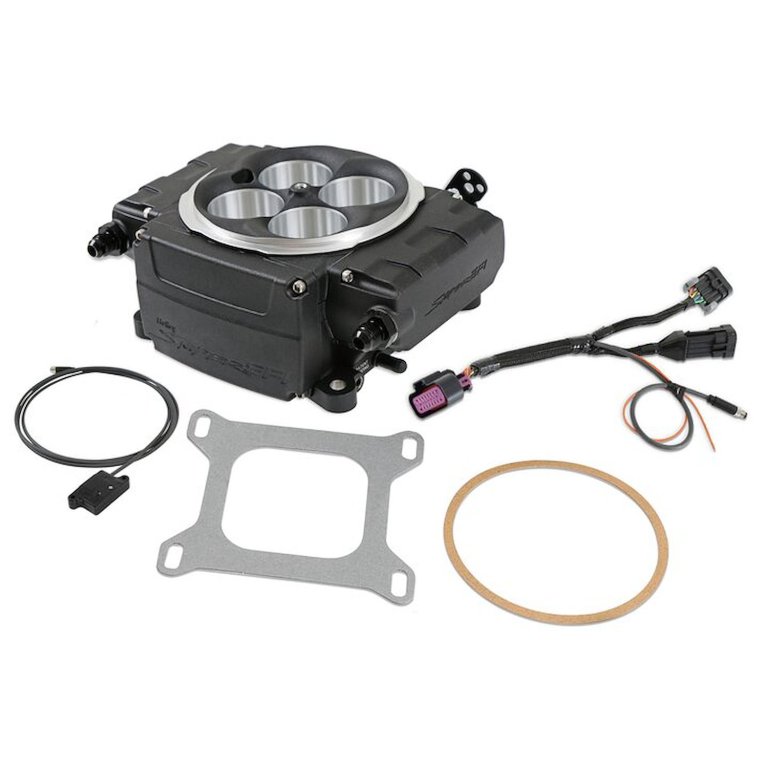We may earn revenue from the products available on this page and participate in affiliate programs. Learn more ›

Carburetors get a bad rap. They honestly are a lot easier to work with and a lot more reliable than people think they are. They’re just not as easyt o work with as an EFI system, which is hands-off after installation and setup. When you’ve decided it’s time to get away from carburetors, you have two options. You can opt to revamp your ride with a late-model engine swap. That’s always great, but requires a lot of time, money, and resources. Or you can make a relatively quick upgrade to electronic fuel injection.
Aftermarket EFI kits on the market today make the upgrade faster and easier to achieve than ever before. Today’s kits are as close as you’re going to get to a bolt-on upgrade. They will eliminate cold start and tuning issues associated with carburetors. For many folks, this is the best way to achieve improved driveability and fuel economy. And that will ultimately keep more classic vehicles on the road. The only downside is that there are quite a few options to pick from when looking at the best aftermarket EFI system. Thankfully, a quick guide’s all it takes to sort things out.
Our Methodology
EFI systems are nothing new to the aftermarket. If you’re a classic car nut like myself and other members of The Drive’s team, you spend a lot of time reading about them. They’re something that we know more than enough about to help you decide which belongs on your car. That doesn’t mean we view our minds as the only source of information. To ensure we put together a list of recommendations and buying guides that are truly useful to you, we take the time to research the latest offerings from leading manufacturers. We also read many customer reviews to find out which are the best EFI systems on the market.
The Best Aftermarket EFI Systems Reviews & Recommendations
Best Overall: Holley Sniper EFI 2
Like its legendary 4150 carburetors, Holley’s Sniper EFI is a clear choice for so many builds that there’s no way for it not to take our top pick. For starters, Holley’s Sniper EFI systems are a TBI type designed to bolt onto existing intake manifolds. The standard four-barrel option includes a dual-pattern flange. This allows it to bolt in place of square 4150 or spread-bore four-barrel carburetors.
The biggest reason for the Sniper EFI taking our top pick is the simplicity of installation, which has become even better with the second generation. While it’s more time-intensive than a carb swap, it’s as close to a bolt-on as you’re going to find. It relies on only a few electrical connections and can use Holley’s clamp-on oxygen sensor mounts that eliminate the need for welding. It’s also a self-learning system, meaning you don’t need to be a tuning expert to get it running.
Different kits are available to shorten the shopping process as well. This particular kit is one of the less-inclusive versions. Its great for those who just need the EFI system itself because they already have a fuel system in mind. That makes for a more economical price, but it means you’ll need to shop for the remaining components necessary to make it run. That said, another strong point of the Sniper EFI 2 system is that it allows you to build an entire ecosystem with high-performance components that are equally as simple to install.
Each Sniper setup will support different power ranges. This is capable of feeding engines turning out up to 650 horsepower. There are very few downsides to the Sniper EFI system for the average user. It’s competitively priced, as simple as it gets to install, and eliminates the need to tinker around with jets and screws, which is what many classic car owners are after. However, there are some issues you should be aware of. Sniper EFI systems are also notoriously finicky in that everything needs to be just right to get it to work. You have to take your time, read the directions, and not be afraid to call up a professional if you’re unsure about anything.
Other Recommendations
Holley’s Sniper EFI 2 system is a great option for many, but it’s not the best for every situation. Your build and personal preferences might require something else. That’s why we included a list of alternative options below.
- Best Value: FiTech Go EFI 4 600 HP System
- Honorable Mention: Edelbrock Pro-Flo 4 EFI Traditional 4150-Style Kit
- Best Dual-Quad: Holley 550-1074 Terminator X Stealth 4150 Dual Throttle Body EFI System
- Best 6-Pack: FiTech 3×2
Things to Consider Before Buying The Best Aftermarket EFI Systems
There’s a lot to consider before you jump on the first EFI system you come across. Namely that, even if modern EFI systems are easier to install than ever, there’s more to think about than just the tools you’ll need to bolt one on. Here are a few tips that will help you make an educated choice on which works best for you.
Key Features
Type
There are two primary types of EFI systems you can choose from. The first and most-likely choice is throttle body injection (TBI). These are the most simple and affordable types out there. This type works by placing the fuel injectors in the throttle body, creating a situation where a controlled mixture of fuel and air is pulled through the manifold. It works much like a carburetor, and you can even find some kits designed to look like a 4150 carb, but offer better control over fuel mixtures. Multiport injection is the other option. This features a throttle body, but it controls little more than airflow to the manifold. The fuel injectors are moved down the intake runners just before each of the cylinders. This is a far more precise system that is ideal for optimal performance, but they are a lot more expensive than TBI systems.
Power Level
Fuel injection systems are unlike carburetors in that they give you a set horsepower range they’re designed to work with as opposed to a CFM rating. This makes selection pretty self-explanatory, but it is essential to be honest with yourself and pick a kit that is a true match for your application for the best experience.
Manifold Compatibility
Multiport injection systems typically come with replacement intake manifolds, so those buyers just need to ensure they pick the right fit for their engine. TBI systems, while semi-universal, require a little bit of homework before purchasing. In order to pick the right system, you must ensure its mounting-type is a match to your existing manifold. Manufacturers offer kits to work with single, two, and 4-barrel setups. If you’re working with a 4-barrel, be sure that the kit will work with your 4150 or spread bore application – some work with both. Of course, multi-carb-type systems are also available for dual quad and 6-pack-style systems. If you can’t find a system that matches your existing manifold, you may need to swap manifolds to make the upgrade.
Tips
- Fuel system upgrades are mandatory. EFI systems work on much greater fuel pressures than carburetors. You’re going to need to make the upgrade to a fuel pump that can support your new EFI system and add a fuel-return line to the mix. Some EFI kits come with a fuel pump and plumbing to solve this issue, but it’s something to read into as you might need to come up with your own combination.
- Consider your ignition. Most EFI systems offer some type of ignition control system to help you get the most out of your investment. It’s worth reading into your kit to verify whether or not ignition system upgrades are required or if they’re an option for your kit.
- Take your time. A lot of people get into this thinking it’s a simple bolt-on swap, but it can be rather time intensive and is highly reliant on getting the details right. Make sure to follow the directions closely and give the project as much time as it needs. If you get confused or need help, manufacturer tech lines are a great source to fall back on.
- Not a problem solver. An EFI system can only solve the problems it’s designed to. It’s not going to fix problems that aren’t related to the fuel delivery system. If the heads are leaking, the rings are fried, or the engine needs an overhaul, you need to get that sorted out before you try to move to an EFI system. Otherwise, you might end up with more trouble than you started with
- May need more juice. Don’t be surprised if your factory charging system can’t keep up with your EFI system, especially if you have other upgrades like aftermarket lighting and an aftermarket stereo system soaking up the supply. Remember that the factory alternators on classic cars only needed to supply power to a few accessories. You may need to upgrade to a more powerful unit.
Pricing
EFI systems alone usually cost anywhere from around $900 to $3000. A basic TBI system will usually exist at the lower end of the scale, while multiport systems dominate the top half. That price likely won’t cover everything, though. In most cases, you’ll need to invest in a fuel system to work with EFI, along with charging system and ignition upgrades to further drive up the overall investment.
FAQs
You’ve got questions. The Drive has answers.
A: Yes and no. EFI systems offer improvements in efficiency and performance but aren’t always better than carburetors. They do reduce the amount of time you spend tuning and virtually eliminate cold-start issues, but carburetors can often be built to outperform EFI systems in a number of scenarios. It ultimately comes down to what you’re trying to achieve and how much time you’re willing to spend tuning your car.
A: That depends on how far off your carburetor is in the first place. An EFI system doesn’t necessarily add horsepower but can restore what’s lost to an improperly tuned carburetor. That doesn’t mean you’ll always pick up horsepower by making the swap, though.
A: An EFI system can come with most of what you need to bolt it on. Some kits might even come with ignition and fuel system components. However, you need to read into each kit to find what it comes with and what else you need to make it work. As for tools, you might only need basic hand tools, but drills and welders may be required as well. Again, it depends on the kit you’re working with.
A. Yes. Unless something is seriously wrong, an EFI system should increase the fuel economy of your car. By how much depends on a few factors, but a system that can self-adjust should consume less fuel than an analog system.



